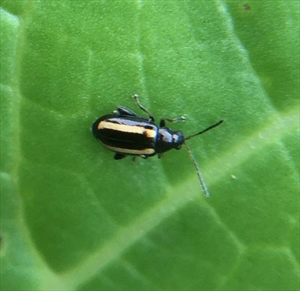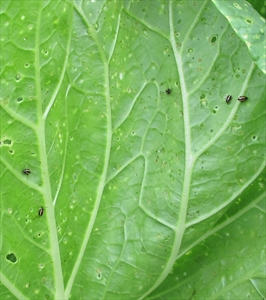Lesser striped flea beetle, small striped flea beetle, flea beetle, turnip flea beetle
Pacific Pests, Pathogens and Weeds - Online edition
Pacific Pests, Pathogens & Weeds
Chinese cabbage flea beetle (166)
Phyllotreta undulata
Wide distribution in the sub-tropics and temperate countries. In Oceania, it has been recorded from Australia, Fiji, New Caledonia and Vanuatu.
Members of the cabbage family, Brassicaceae (Cruciferae), Chinese cabbage in particular.
The adult beetles do the damage. They are 2 mm long, with a pair of wide yellow stripes on their wing cases (Photos 1&2). Adults feed on the leaves, and the larvae feed on the fine roots. Pupation takes place in small cocoons in the soil. The life cycle from egg to adult is about 3-4 weeks.
Spread of the beetle is by flight and wind over short distances, and by the domestic and international trade in fresh vegetables.
This is a very serious pest, especially on Chinese cabbage. The adult beetles feed on leaves by scraping, and by making many small holes (Photo 3&4). The Chinese cabbages become unfit for sale.
Growth of seedlings can be checked by the attack and even killed. Larger plants continue to grow and produce leaves, but when populations are high, the leaves are full of holes, and the plants become unmarketable.
The beetle can spread several virus diseases, e.g., Turnip rosette virus, Turnip yellow mosaic virus and Turnip crinkle virus . However, the virus is usually less of a problem than the direct feeding by the adult beetles.
Look for the pinprick-size scrapings and holes in the leaves. Look for tiny beetles (2 mm long) with two broad yellow stripes on their backs. They can be found within the whorl of new leaves and on the back of older ones.
NATURAL ENEMIES
Nothing is known about the natural enemies of this pest in the South Pacific.
QUARANTINE
Countries that have not yet recorded the presence of Phyllotreta undulata will need to consider potential pathways for the introduction for this serious pest, and ensure that they do not allow its entry.
CULTURAL CONTROL
Before planting:
- Do not plant Chinese cabbages on the same land where they were harvested recently. Phyllotreta eggs and larvae will still be in the soil ready to emerge and infest the new crop.
- Do not plant crops near to those that are already infested with the beetles.
- Do not plant downwind from infested crops.
During growth:
- Use manure, compost or commercial fertilizers to accelerate seedling growth.
- Use sticky traps to monitor the present of the flea beetle. These are rectangles of cardboard, coated with grease. Attach these to a wooden pole, e.g., a broom handle, and move it quickly along the rows of plants. As the flea beetles jump, they stick to the grease.
After harvest
- Collect and burn as much of the remains of the crop as possible when harvest is complete.
- Practice crop rotation. Replant with crops that are not in the cabbage family.
RESISTANT VARIETIES
Probably all varieties of Chinese cabbage are susceptible to attack by this beetle; however, head cabbages (green and purple varieties) are not attacked in Vanuatu.
CHEMICAL CONTROL
Such is the importance of this insect that chemical control may be necessary. Do the following:
- Use plant-derived products, such as derris, pyrethrum or chilli (with the addition of soap).
- Test local varieties of Derris (fish poisons) for their effectiveness as a spray. Note, Derris contains rotenone, so it should be used with caution.
- Alternatively, use synthetic pyrethroids as they are likely to be effective, but they will also kill natural enemies, if present.
____________________
When using a pesticide, always wear protective clothing and follow the instructions on the product label, such as dosage, timing of application, and pre-harvest interval. Recommendations will vary with the crop and system of cultivation. Expert advice on the most appropriate pesticides to use should always be sought from local agricultural authorities.
AUTHOR Grahame Jackson
Information from Phyllotreta undulata (flea beetle lesser striped). Crop Protection Compendium. (https://www.cabi.org/cpc/datasheet/40785).
Produced with support from the Australian Centre for International Agricultural Research under project PC/2010/090: Strengthening integrated crop management research in the Pacific Islands in support of sustainable intensification of high-value crop production, implemented by the University of Queensland and the Secretariat of the Pacific Community.







